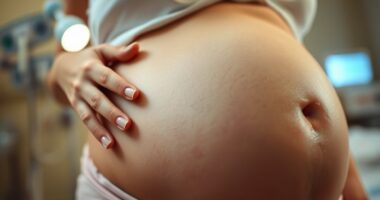After delivery, prioritize rest and recovery for the first few days. Minimize activity to reduce stress and help your body heal. Manage pain with padsicles, cushions, or NSAIDs. Stay hydrated and eat fiber-rich foods to aid digestion. Gently start Kegel exercises and consider light yoga or walking. Pay attention to your emotional health and lean on your support system. By taking these initial steps, you’ll pave the way for a smoother recovery journey. More helpful tips await.
Key Takeaways
- Prioritize rest and minimize activities for the first three days to promote healing and reduce stress.
- Manage pain effectively with padsicles, NSAIDs, and warm sitz baths to enhance comfort during recovery.
- Stay hydrated and consume high-fiber foods to support digestion and prevent constipation.
- Start gentle Kegel exercises and postpartum yoga to aid physical recovery, focusing on breathing techniques.
- Lean on your support system for emotional help and engage in self-care to promote mental well-being.

Postpartum recovery can feel overwhelming, especially with all the changes your body goes through after childbirth. The first three days post-delivery should focus on rest and recovery. Minimizing activity during this time can help lower cortisol levels and promote healing. You might feel tempted to jump back into your usual routine, but giving your body the rest it needs is crucial.
Pain management is also a priority; consider using padsicles, donut cushions, and nonsteroidal anti-inflammatory drugs (NSAIDs) to alleviate perineal pain. Managing vaginal/perineal pain effectively can significantly improve your comfort during this time.
Pain management is essential; utilizing padsicles, donut cushions, and NSAIDs can significantly ease perineal discomfort.
Hydration and diet play vital roles in your recovery. Aim to drink plenty of water and eat foods high in soluble fiber to help with bowel movements and overall healing. A solid support system can make a world of difference. Reach out to family or friends who can share responsibilities and lend a hand when needed.
Regular check-ins with healthcare providers are essential too, as they can help you monitor any potential postpartum complications.
Once you feel ready, you can start incorporating physical recovery techniques. Gentle Kegel exercises can begin within the first week to strengthen your pelvic floor muscles. Diaphragmatic breathing techniques can also help ease tension.
Consider engaging in gentle exercises like postpartum yoga or walking to aid in gradual recovery. If you’ve had a C-section, using a belly band can provide much-needed abdominal support during healing. Warm sitz baths can soothe perineal pain and promote healing as well.
If you’d a C-section, pay attention to your incision care. Supporting the incision site with a pillow when you cough or move can help reduce discomfort. Using stool softeners and increasing your fiber intake can prevent straining during bowel movements, which is particularly important after surgery.
Staying hydrated is crucial for digestion, so keep that water bottle nearby.
Don’t overlook your emotional and mental health during this period. Regular self-assessments of your mental state are important. Lean on your support networks to help manage stress.
Make sure to prioritize rest, which is vital for both physical and mental recovery. If you find yourself struggling, don’t hesitate to seek professional help. Lastly, don’t forget about self-care; engaging in activities that promote your well-being is essential as you navigate this new chapter.
Frequently Asked Questions
How Long Does Postpartum Recovery Typically Take?
Postpartum recovery typically takes about six weeks, but it can vary based on your delivery type and any complications you experienced.
If you’d a vaginal delivery, you might find your recovery faster than with a C-section. Factors like labor duration and any tears or episiotomies play a role too.
What Are Common Signs of Postpartum Depression?
Common signs of postpartum depression include feeling sad or tearful most of the time, irritability towards your baby or partner, and a loss of interest in things you once enjoyed.
You might feel exhausted, even if you get enough sleep, and struggle with negative thoughts or guilt about your parenting.
You may also notice changes in appetite, difficulty concentrating, or withdrawal from social interactions.
Recognizing these signs is crucial for seeking support.
Can I Exercise During My Postpartum Recovery?
Absolutely, you can exercise during your postpartum recovery!
It’s like diving into a sea of rejuvenation. While gentle activities like walking can start within days, you’ll want to wait for that golden 6-week check before tackling more intense workouts.
If you had complications or a C-section, take it slow and listen to your body.
How Should I Care for My Incisions After a C-Section?
After a C-section, you should care for your incision by keeping it clean and dry.
Shower as needed, letting warm water run over it gently, and pat it dry afterward.
Watch for signs of infection, like increased redness or drainage.
Avoid baths and pools until your healthcare provider gives the go-ahead.
Use pain medications as directed, and support your abdomen when coughing or sneezing to protect the incision during healing.
When Can I Resume Sexual Activity After Childbirth?
You can usually resume sexual activity about 4 to 6 weeks after childbirth, but it really depends on your comfort level and recovery.
Make sure you’re feeling physically healed and emotionally ready. It’s important to communicate openly with your partner about any concerns.
If you experience discomfort or pain, consider trying different positions or using lubricants.
Always check in with your healthcare provider during your postpartum visit for personalized advice.
Conclusion
In the delicate dance of postpartum recovery, take each step as a cherished note in your new symphony of motherhood. Embrace the rhythm of healing, allowing yourself grace as you navigate this transformative journey. Like a flower unfurling its petals, you’ll blossom anew, stronger and more radiant than ever. Remember, it’s okay to lean on others; even the tallest trees need support. Your path may be winding, but each stride brings you closer to the beautiful life ahead.









